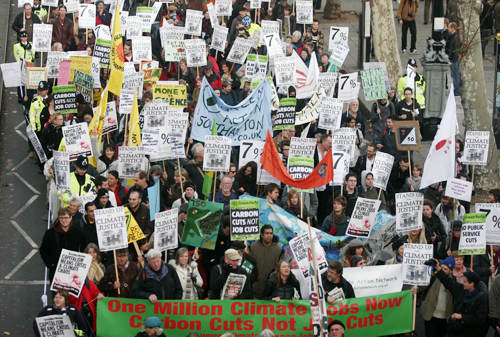|
 |
|
CARBON CUTS: Environmentalists hold banners in London on December 3, 2011, calling for drastic cuts in global greenhouse gas emissions (XINHUA) |
He said China's rapid development has made tremendous achievements during the past 30 years. However, the current economic development mode is unsustainable because pressure on the environment and energy resources keeps increasing.
"China has now come to a stage at which an economic transition is essential," Du said. The efficiency of resource utilization must be enhanced, while resource consumption must be decreased. In the past, the country's economic development created big environmental problems. Now, China must pursue environmentally friendly growth by promoting innovation and encouraging high-value-added industries.
Since 2001, China's energy consumption has grown rapidly. It increased 2.2 times from 2001 to 2010, putting great pressure on resources and the environment. China's GDP accounted for 9.5 percent of the world's total in 2010, but its energy consumption represented 19.5 percent of the world's total. Its greenhouse gas emissions were nearly one quarter of the global total. China's energy consumption, pollution discharge and carbon emissions per unit of GDP all stand at high levels.
The traditional mode of economic development is the root cause of high resource consumption, said Du. For example, the United States became a developed country after over 200 years, and has high per-capita energy consumption. The country's population is less than 5 percent of the world's total, but its annual energy consumption represents 20 percent of the world's total. If every country in the world were to reach such a development level, this would require the resources of four to five Earths, which would be a disaster for the whole world.
China should realize its modernization with per-capita energy consumption significantly lower than that of developed countries like the United States. This is why China needs to follow a new path of industrialization, Du said. This new path, featuring green and low-carbon development, calls for energy saving, the efficient and clean utilization of fossil energy, and the development of non-fossil energy. "This is a win-win energy strategy for both the economy and the environment, which can satisfy the demand of China's sustainable development," said Du.
Fossil fuels account for about 90 percent of China's current primary energy consumption, in which coal occupies about 70 percent. The efficient and clean utilization of coal will be a key point for saving energy and reducing emissions. Currently 55 percent of China's oil consumption relies on imports. The country must save oil and develop alternatives to oil. Since natural gas is a relatively clean source of fossil energy, increasing the use of natural gas should be part of China's energy strategy, Du said.
Non-fossil energy includes renewable energy and nuclear energy. Non-fossil energy occupies less than 10 percent of China's energy structure. By 2015, this proportion is expected to reach 11.4 percent. By 2020, non-fossil energy will account for 15 percent of China's energy mix, and by 2050, about 40 percent. "In this way, China will perfect its energy structure and reduce greenhouse emissions," Du said.
Since global warming is still happening, China must take measures to limit emissions and adapt to changing climate conditions. "The active way of coping with climate change brings new development opportunities to China. China's green transformation will contribute to the healthy and sustainable development of China and the world," Du said.
Key Statistics
- The global average surface temperature has risen 0.74 degrees Celsius in the past century
- 2011 was the ninth warmest year since 1880 and the warmest La Nina year since 1951
- The average surface temperature in China has increased 1.38 degrees Celsius since 1951
- 2007 was the warmest year and 2001-10 was the warmest decade in China in the past century
- 2011 was the 14th warmest year in China since 1951
Email us at: dingying@bjreview.com | 